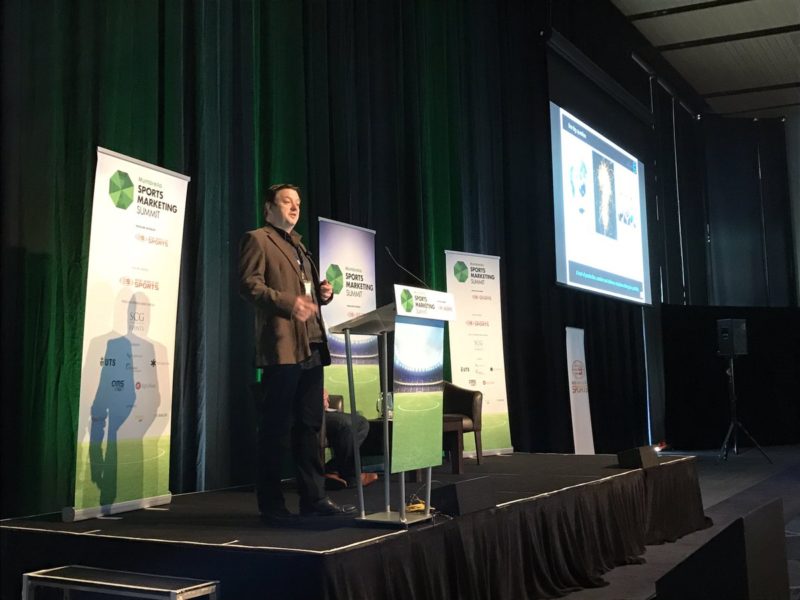Gambling advertising has ‘crossed a line’ for TV sports fans, new study reveals
Gambling advertising has ‘crossed a line’ in recent years and betting firm representatives are being positioned as equal to sports experts, a new study by Clarity Strategic Research has suggested.
Speaking at Mumbrella’s Sports Marketing Summit, Clarity Strategic Research directors Alasdair Johnston and Alex Sweeney told the audience the biggest bug-bear for TV sports viewers and fans was gambling advertising.
The qualitative study, which involved 20 one-hour long interviews with Australians nationally, reported sports fans do not have problems with sponsorship and advertising, with the exception of betting firms.
Australians involved in the study reported disdain when betting firms were integrated into the sports telecast, positioned as part of the commentary by offering ‘live odds.’
“Gambling advertising is a consistent bug-bear to TV sports viewers. The commonly made assertion is that gambling advertising and sponsorship has ‘crossed a line’ in recent years, and there is widespread concern that ‘betting firm representatives’ are being positioned as equals to the sports ‘experts’ on shows,” Sweeney said.
“When you pan around the screen you might have the esteemed former players observing the game and then on the sofa beside them is the betting representative giving their point of view on the game.”
As part of the proposal, the government will introduce more restrictions on gambling advertisements during live sports broadcasts shown on commercial TV, commercial radio, subscription TV and the Special Broadcasting Service.
Also in the session, Johnston and Sweeney pointed out that changes and improvements in the quality of television delivery as a challenge for Australian sporting codes.
The study indicated TV had superseded live games, due to the cost, level of access, poor categorising and lack of comfort at sporting grounds across Australia.
Sweeney said: “Sports bodies and leading sports stadiums have a massive opportunity to upgrade the live sports experience in Australia. Consistent criticisms are made in term of amenities, customer service, catering and comfort.
“Australians want to attend ‘live sport events’ but feel more effort is required to encourage their participation.”
In addition to, viewers are now spreading themselves thinly across a range of different sports, creating competition for eyeballs for more traditional sports.
“The general ‘TV’ viewing market has changed fundamentally with the advent of Netflix and SVOD. In line with that, the viewing of sport on TV has changed irrevocably too.
“Whether it’s bite-size sports via social media, the easily accessible myriad of global options or the improved TV presentation of sports locally – Australian sports viewers say ‘they have never had it so good,'” Sweeney said.
“The changes in TV delivery and consumer mindsets present both a challenge and opportunity to Australia’s sporting codes and broadcasters. The BBL and women’s AFL show that the TV sports industry can respond positively and that viewers are receptive to innovation and new thinking.”



The 8:30 cutoff concerning gambling advertising is not really good enough because you have some families who will make a point of staying up to watch a very important fixture played on the “other side of the world”, be it a Wimbledon tennis final featuring a key player or a World Cup soccer showdown. Sometimes some expat families stay up for the fixtures that were held in high esteem in their home country such as for American expats to watch the Super Bowl.
Another practice that comes in to play with sports enthusiasts who use DVRs and enjoy the overnight fixtures is that they want to use these devices to record the whole fixture and watch the recording they made rather than a highlights package typically ran during the day. This is although they use the DVR’s picture-search functionality to bypass advertising, but some enthusiasts may play through the pre-game commentary to get a good idea about what to expect and, perhaps, to see the pre-game warmup events. The issue here is that the pre-game commentary and on-screen graphics could be used by a betting company for spruiking odds and that would go against the spirit of banning gambling advertising.
What can be investigated is the idea of extending the ban on gambling advertising beyond 8:30pm to protect the key events run over the other side of the world from odds-spruiking and gambling ads, especially in the context of DVR users or families staying up late.